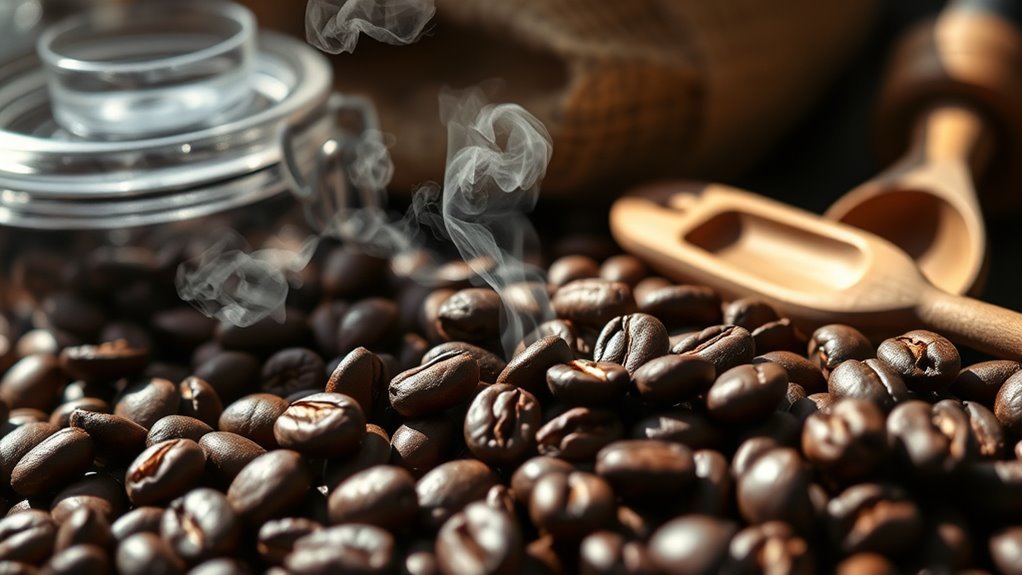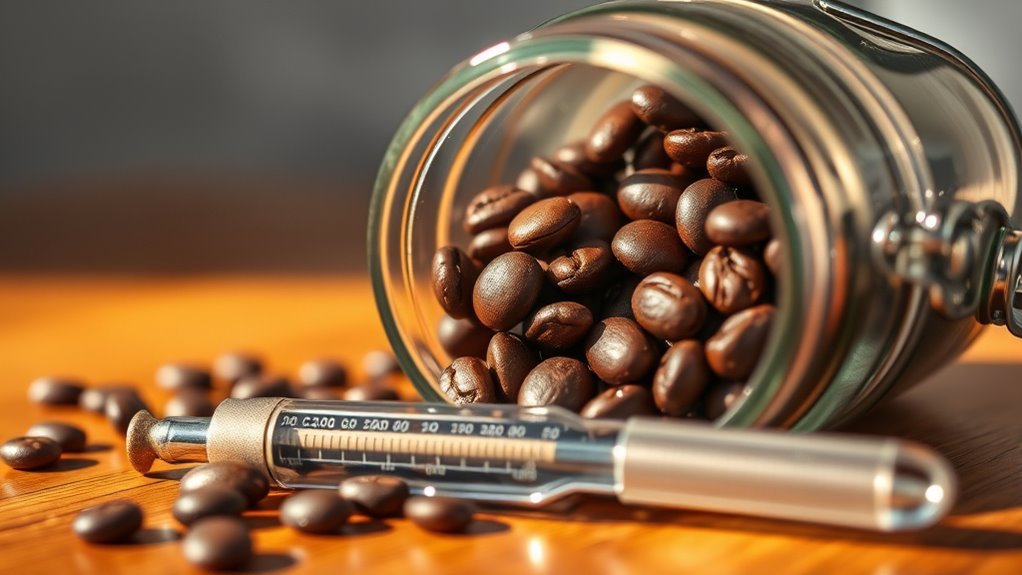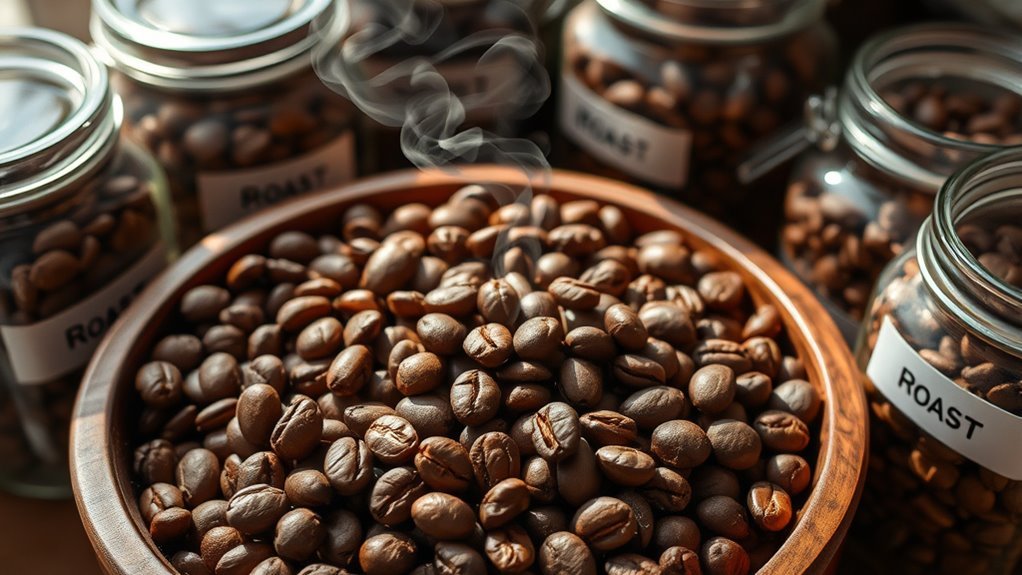The Science of Coffee Freshness: How to Keep Your Beans Fresh
To keep your coffee beans fresh, you need to control degassing by allowing CO2 to escape shortly after roasting without letting excess oxygen in, which accelerates staleness through oxidation. Store beans in airtight, opaque containers to limit moisture absorption and light exposure, which degrade flavor. Keep them cool, ideally below 25°C, and avoid heat fluctuations to prevent chemical breakdown. Managing these factors preserves volatile compounds essential for taste—exploring further reveals why specific storage choices matter.
Understanding Coffee Bean Degassing

Although you might not notice it immediately after roasting, coffee beans undergo a vital process called degassing, where they release carbon dioxide trapped inside. This degassing process greatly influences the coffee’s freshness timeline. Right after roasting, beans emit substantial CO2, which gradually decreases over days to weeks. This release affects flavor extraction and aroma, making timing essential for ideal brewing. If you brew too soon, the excess CO2 can cause uneven extraction, while waiting too long diminishes vibrant flavors. Understanding this timeline empowers you to control when your coffee is at its peak freshness, allowing you to enjoy full-bodied taste and aroma. Mastering degassing means embracing the natural transformation of your beans, giving you freedom to brew exceptional coffee on your terms.
The Role of Oxygen in Coffee Staleness
While degassing influences how soon you should brew your coffee, another factor that determines freshness over time is exposure to oxygen. Oxygen interaction with coffee beans triggers oxidation, a chemical reaction that degrades essential oils and aromatic compounds responsible for flavor. This process accelerates staleness, diminishing your coffee’s quality quickly. To effectively prevent staleness, you need to limit oxygen exposure by using airtight containers and minimizing the beans’ surface area in contact with air. Vacuum sealing or one-way valve bags also help by allowing degassing without letting oxygen in. Understanding and controlling oxygen interaction is vital if you want to maintain the freedom to enjoy fresh, flavorful coffee whenever you choose. By prioritizing staleness prevention through oxygen control, you guarantee your beans retain their best taste longer.
Impact of Moisture on Coffee Quality
Because coffee beans are hygroscopic, they readily absorb moisture from their environment, which can greatly impact their quality. You need to understand humidity effects to preserve freshness. When beans absorb excess moisture, it accelerates chemical reactions that degrade flavor compounds and promote microbial growth, leading to off-flavors and spoilage. Conversely, too little moisture can dry beans out, diminishing aroma and causing uneven extraction during brewing. Studies show that maintaining moisture content around 10-12% is ideal for balancing freshness and stability. To control moisture absorption, store your beans in airtight containers in low-humidity environments. Avoid exposing them to fluctuating humidity levels, which cause repeated moisture gain and loss, further degrading quality. Managing moisture precisely lets you keep your coffee’s full flavor potential intact, giving you the freedom to enjoy every cup at its best.
Effects of Heat on Coffee Flavor

You’ll notice that exposure to heat accelerates flavor degradation in coffee by breaking down key aromatic compounds. Maintaining ideal storage temperatures—typically below 25°C—helps preserve these delicate flavors and prevents heat-induced aroma loss. Understanding this temperature threshold is essential to keeping your coffee fresh and flavorful for longer periods.
Heat and Flavor Degradation
As heat exposure increases, the delicate compounds responsible for coffee’s aroma and taste begin to break down, resulting in noticeable flavor degradation. You want to minimize heat retention during storage to preserve these volatile compounds. Excessive heat accelerates oxidation and evaporation, leading to a flat, stale taste.
| Heat Exposure Level | Chemical Impact | Flavor Outcome |
|---|---|---|
| Low | Minimal compound breakdown | Fresh, vibrant |
| Moderate | Partial volatile loss | Slightly muted |
| High | Extensive breakdown | Stale, bitter notes |
| Prolonged High | Complete degradation | Unpleasant, rancid |
| Controlled Cooling | Preserves flavor integrity | Ideal freshness |
Understanding this helps you control heat exposure, ensuring maximum flavor preservation and freedom to enjoy your coffee as intended.
Optimal Storage Temperatures
Maintaining coffee at temperatures between 10°C and 20°C (50°F to 68°F) is critical for preserving its flavor compounds and preventing premature staling. Temperature control within this range guarantees the ideal conditions that slow down chemical reactions responsible for flavor degradation. When coffee is exposed to heat above 20°C, volatile oils evaporate rapidly, diminishing aroma and taste complexity. Conversely, temperatures below 10°C can cause moisture condensation, risking mold and spoilage. To maximize freshness, you should:
- Store beans away from direct sunlight and heat sources
- Use airtight containers that buffer temperature fluctuations
- Keep coffee in a cool, dark place with steady temperature
Heat-Induced Aroma Loss
Though heat can enhance some aspects of coffee’s aroma during brewing, prolonged exposure to elevated temperatures causes volatile compounds to evaporate rapidly, leading to significant aroma loss. You need to understand that heat exposure effects degrade essential oils responsible for coffee’s signature fragrance, diminishing flavor complexity over time. Scientific studies confirm that maintaining low, stable temperatures slows this degradation, preserving aromatic integrity. To safeguard your coffee’s freshness, adopt aroma preservation techniques like airtight containers stored away from heat sources. Avoid direct sunlight and avoid leaving beans near ovens or warm appliances. By controlling heat exposure, you not only extend your coffee’s shelf life but also retain the nuanced flavors that make each cup enjoyable. Ultimately, mastering heat management empowers you to savor coffee as its roasters intended.
How Light Exposure Alters Coffee Beans
You might not realize that UV rays can degrade coffee beans by breaking down essential oils and altering flavor compounds. When beans are exposed to light, these chemical changes accelerate, reducing freshness and taste quality. That’s why packaging designed to block light is critical for preserving the beans’ ideal flavor profile.
UV Rays and Beans
Although coffee beans may seem resilient, exposure to UV rays initiates chemical changes that degrade their quality over time. UV radiation accelerates oxidation in beans, breaking down essential oils and aromatic compounds, which directly impacts flavor and aroma. The light intensity and duration of exposure play critical roles in this degradation process. Without proper UV filtration, you risk losing the nuanced taste profiles you cherish.
Consider how UV rays affect your beans:
- Dulling of complex flavor notes, reducing coffee’s vibrancy
- Increased staleness due to oil breakdown, limiting freshness
- Loss of antioxidant properties, weakening health benefits
To preserve your freedom to enjoy fresh coffee, controlling light intensity and ensuring UV filtration are essential steps in maintaining bean integrity.
Packaging for Light Protection
Many factors influence how light exposure alters coffee beans, but packaging plays a crucial role in mitigating this damage. When beans are exposed to light, especially UV rays, they undergo chemical changes that degrade flavor and aroma. Using light filtering bags or opaque containers can greatly reduce this deterioration. These packaging options block harmful light, preserving the beans’ freshness and extending shelf life.
| Packaging Type | Light Protection Level | Benefits | Drawbacks | Ideal Usage |
|---|---|---|---|---|
| Light Filtering Bags | Moderate | Allows some breathability | Less durable | Short-term storage |
| Opaque Containers | High | Blocks all light | Bulkier, less breathable | Long-term storage |
Choosing the right packaging grants you freedom to enjoy your coffee at peak freshness.
Best Containers for Storing Coffee Beans
Since oxygen, moisture, heat, and light are the primary factors that degrade coffee beans, selecting the right container is essential to preserving freshness. You want to choose storage options that minimize exposure to these elements. Vacuum containers and airtight jars are proven to be highly effective in maintaining bean quality by creating a sealed environment, preventing oxidation and moisture intrusion.
Choosing airtight, vacuum-sealed containers protects coffee beans from oxygen, moisture, heat, and light, preserving freshness.
Consider these container features to keep your coffee vibrant and flavorful:
- Vacuum containers: Remove excess air, markedly slowing staling.
- Airtight jars: Seal tightly to block oxygen and humidity.
- Opaque materials: Shield beans from light damage.
Ideal Environmental Conditions for Coffee Storage
When you store coffee beans, controlling the environment is just as essential as choosing the right container. Maintaining the ideal humidity—around 50%—prevents beans from absorbing excess moisture, which can degrade flavor and promote mold. Conversely, too little humidity causes beans to dry out, losing aromatic oils critical for freshness. Temperature balance is equally crucial; beans fare best stored at a consistent, cool temperature, ideally between 60°F and 75°F (15°C to 24°C). Fluctuations accelerate staling by triggering condensation and oxidation. Avoid exposing beans to heat sources or direct sunlight, as elevated temperatures speed up chemical reactions that diminish quality. By optimizing both ideal humidity and temperature balance, you preserve the beans’ volatile compounds, extending their freshness and flavor, granting you the freedom to enjoy exceptional coffee anytime.
Frequently Asked Questions
Does Grinding Coffee Beans Affect Their Freshness Speed?
Did you know coffee loses about 60% of its aroma within 30 minutes after grinding? Your grinding method drastically speeds up freshness loss since it increases surface area exposure to oxygen. Even with ideal storage conditions, ground coffee stales faster than whole beans. If you want to savor freedom in flavor, grind only what you need right before brewing, then store beans airtight and away from light to preserve their peak freshness longer.
Can Freezing Coffee Beans Preserve Flavor Longer?
Freezing coffee beans can preserve flavor longer, but only if you use proper freezing methods. You should store beans in airtight, moisture-proof containers to minimize oxidation and moisture exposure. Avoid repeatedly thawing and refreezing, as temperature fluctuations degrade flavor. While freezing slows chemical reactions that cause staleness, it won’t stop them entirely. So, freezing helps extend freshness if done carefully, giving you more freedom to enjoy quality coffee without rushing through your beans.
How Long Do Whole Beans Stay Fresh After Roasting?
Whole beans typically stay fresh for about 2 to 4 weeks after roasting, depending on roasting methods and storage techniques. Darker roasts release oils faster, reducing freshness sooner, while lighter roasts preserve compounds longer. To maximize flavor, store beans in airtight containers away from light, heat, and moisture. Proper storage slows oxidation, letting you enjoy fresher coffee and more freedom to savor your brew without rushing through your beans.
Is There a Difference in Freshness Between Arabica and Robusta Beans?
It’s a neat coincidence that both Arabica and Robusta beans can lose freshness at similar rates, yet their bean quality and flavor profile are quite distinct. Arabica, with higher acidity and complex flavors, tends to be more sensitive to staling, while Robusta’s stronger, more bitter profile masks freshness loss better. So, when you’re aiming for peak flavor, understanding these differences helps you choose beans that match your taste freedom and freshness expectations.
Does Altitude Where Coffee Is Grown Influence Bean Freshness?
You’ll find that altitude effects greatly impact bean quality, which in turn influences freshness. Higher altitudes generally slow the coffee cherry’s maturation, leading to denser beans with better flavor profiles and longer shelf life. This means beans grown at higher elevations tend to retain their freshness longer compared to those from lower altitudes. So, if you value superior bean quality and extended freshness, choosing high-altitude coffee is a smart move.






